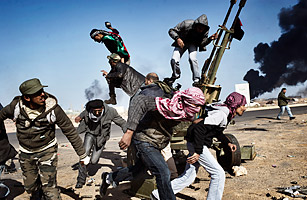
Revolt in Libya
Muammar Gaddafi's four-decade-long dictatorial rule over the oil-rich North African nation of Libya came to a grisly end Oct. 20, 2011, but the months preceding his death were similarly bloody. In early March, uprisings sparked by the Arab Spring unrest in neighboring Egypt and Tunisia exploded into full-fledged civil war, as barely trained militias rose up against Gaddafi's forces, and several prominent allies and generals defected to their cause. Prompted by a rumored threat of genocide should Gaddafi overrun the rebel stronghold of Benghazi, the United Nations adopted a resolution in March that in essence legitimated a foreign intervention. NATO operations formally began at the start of April and steadily rolled back Gaddafi's forces. But the war drifted on for months as Libya's rebels struggled to hold their regained ground, while their Western allies — led by the U.K., France and the U.S. — remained wary of putting their own boots on the ground. By the end of fighting, an estimated 20,000 to 40,000 Libyans had died; hundreds of thousands more had been displaced as refugees. The steady toll of air strikes enabled rebel advances to seize the capital, Tripoli, sending Gaddafi and the last vestiges of his regime scurrying to his hometown of Sirt. On Oct. 20, after being discovered cowering in a sewage ditch, Gaddafi was seized by rebels and killed, his body placed on display in a meat locker in the port city of Misratah.